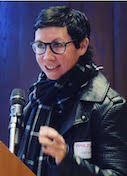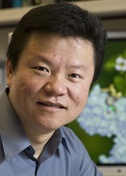Springsteen, Tolkien, Protein
Alwyn Jones and Frodo
Uppsala University, Sweden
Published June 17, 2011
An unexpected side-effect of Alywn Jones's decision to write Frodo, one of the first computer graphics programs written for Xray crystallography, was learning to swear in German. His teacher? Johann Deisenhoffer, the 1988 winner of the Nobel Prize in Chemistry.
“He was always using my experimental versions,” said Jones, then at the Max Planck Institute for Biochemistry, now professor of structural biology at Uppsala University in Sweden. “He used to swear at me when my program exploded, which it often did.” Back then, in 1976, Jones had happened into computer graphics. “I took a wrong turn and I just kept going,” he says, his voice just slightly less gritty than that of The Boss.
Jones programmed on what at the time was a sophisticated computer. “I could have bought three Ferraris for what we paid for that system,” says Jones. But with only 32000 words of memory and just a megabyte of disk storage, writing modeling software was a challenge. To do anything, he had to link his computer to a larger system, creating a flow of data he thought of as a ring. That ring inspired him to name his program Frodo.
In 1979, Jones took Frodo to Uppsala. There he implemented Frodo's original Lego-like model building tool. He built the tool because he had noticed over the years that the same structure fragments kept reappearing in solved structures. He wondered if he could use these fragments to jump-start solving new structures. Pursuing this idea, Jones found many well-refined fragments. “I was surprised to see that I could use these fragments to build a whole protein,” says Jones.
Without such a tool, he says, “someone could end up sitting in front of one of these computer systems and fitting to noise rather than fitting to a realistic expectation. They might end up with models that have incorrect stereochemistry, or parts of the main chain pointing in the wrong direction.”
By the mid-eighties, Frodo's mini-computer hardware platform had become obsolete, replaced by Digital's VAX. “The VAX was the first computer where crystallographers could actually control their computing destiny,” says Jones. “You could do all of the computing on it and not have to use a computer center.”
Jones decided to write Frodo again from scratch for the new hardware, creating “O.” Jones closely guards the meaning of the name. Even collaborator Morton Kjeldgaard of Denmark, who contributed the cartoon representations of proteins in O, does not know. “O is the end of Frodo,” he guessed. Not so. Perhaps O is The One Ring? Jones will not tell.
Regardless, O includes a newer, more elegant implementation of Frodo's Lego-like graphics tool. In O, Jones used a database to store the fragments and other data the program needs, making it easy to support new features as he conceives them. In addition to updating O, Jones also still relies on O to take electron density maps and turn them into models of proteins. For more information about O, please see Essential O, available online.
– Elizabeth Dougherty



























































































